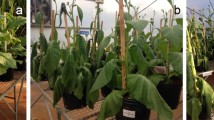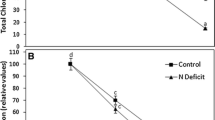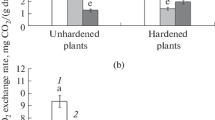Abstract
It is generally believed that a restricted export of carbohydrates from source leaves causes oxidative stress because of an enhanced utilisation of O2 instead of NADP+ as electron acceptor in photosynthesis. To test this hypothesis, developmental changes of antioxidative systems were investigated in wild-type and transgenic tobacco (Nicotiana tabacum L.) suffering from disturbed sink-source relations by expression of yeast invertase in the apoplastic space. Young expanding leaves of the wild type contained higher activities of Superoxide dismutase (EC 1.15.1.1), ascorbate peroxidase (EC 1.11.1.11), catalase (EC 1.11.1.6), dehydroascorbate reductase (EC 1.8.5.1), glutathione reductase (EC 1.6.4.2) and a higher glutathione content than mature source leaves. The activity of monodehydroascorbate-radical reductase (EC 1.1.5.4) and the ascorbate content remained unaffected by the developmental stage in the wild type. In young expanding leaves of the transgenic plants the capacity of the antioxidative systems was similar to or higher than in corresponding leaves from the wild type. Source leaves of transgenic tobacco with an increased carbohydrate content showed a small chlorophyll loss, an increased malondialdehyde content, a selective loss of the activities of Cu/Zn-superoxide dismutase isoenzymes and a fourfold decrease in ascorbate compared with the wild type. There was no evidence that the protection from H2O2 was insufficient since source leaves of transgenic tobacco contained increased activities of catalase, ascorbate peroxidase, and monodehydroascorbate-radical reductase and an increased ascorbate-to-dehydroascorbate ratio compared with source leaves of the wild type. In severely chlorotic leaf sections of the transgenic plants, most components of the antioxidative system were lower than in green leaf sections, but the ascorbate-to-dehydroascorbate ratio was increased. These results suggest that carbohydrate-accumulating cells have an increased availability of reductant, which can increase the degree of reduction of the ascorbate system via glutathione-related systems or via the activity of monodehydroascorbate-radical reductase. At the same time, transgenic tobacco leaves seem to suffer from an increased oxidative stress, presumably as a result of a decreased consumption of O .-2 by Cu/Zn-superoxide dismutases in the chloroplasts. There was no evidence that carbohydrate-accumulating leaves acclimated to enhanced O .-2 production rates in the chloroplasts.
Similar content being viewed by others
Abbreviations
- Chl:
-
chlorophyll
- SOD:
-
Superoxide dismutase
References
Aebi H (1983) Catalase. In: Bergmeyer H (ed.) Methods of enzymatic analysis. Vol. 3. Verlag Chemie, Weinheim, pp 273–277
Ames B, Shigenaga M, Hagen T (1993) Oxidants, antioxidants, and the degenerative diseases of ageing. Proc Natl Acad Sci USA 90: 7915–7922
Asada K (1992) Ascorbate peroxidase — a hydrogen peroxidescavenging enzyme in plants. Physiol Plant 85: 235–241
Asada K, Takahashi M (1987) Production and scavenging of active oxygen species in photosynthetic tissues. In: Kyle D, Osmond C, Arntzen C (eds) Photoinhibition. Elsevier Science Publishers BV, New York, pp 227–287
Asada K, Takahashi M, Nagate M (1974) Assay and inhibitors of spinach Superoxide dismutase. Agric Biol Chem 38: 471–473
Beauchamp C, Fridovich I (1972) Superoxide dismutase: Improved assay and an assay applicable to polyacrylamide gels. Anal Biochem 44: 276–287
Bielawski W, Joy K (1986) Reduced and oxidized glutathione and glutathione reductase activity in tissues of Pisum sativum. Planta 139: 9–17
Borraccino G, Dipierro S, Arrigoni O (1989) Interaction of ascorbate free radical reductase with sulphhydryl reagents. Phytochemistry 28: 715–717
Bowler C, Alliotte T, De Loose M, Van Montagu M, Inzé D (1989) The induction of manganese Superoxide dismutase in response to stress in Nicotiana plumbaginifolia. EMBO J 8: 31–38
Bowler C, Van Montagu M, Inzé D (1992) Superoxide dismutase and stress tolerance. Annu Rev Plant Physiol Plant Mol Biol 43: 84–116
Cakmak I (1994) Activity of ascorbate-dependent H2O2-scavenging enzymes and leaf chlorosis are enhanced in magnesium and in potassium-deficient leaves, but not in phosphorus-deficient leaves. J Exp Bot 45: 1259–1266
Cakmak I, Marschner H (1992) Magnesium deficiency and high light intensity enhance activities of Superoxide dismutase, ascorbate peroxidase, and glutathione reductase in bean leaves. Plant Physiol 98: 1222–1227
Cakmak I, Hengeler C, Marschner H (1994) Changes in phloem export of sucrose in leaves in response to phosphorus, potassium and magnesium deficiency in bean plants. J Exp Bot 45: 1251–1257
Casano LM, Martin M, Sabater B (1994) Sensitivity of Superoxide dismutase transcript levels and activities to oxidative stress is lower in mature-senescent than in young barley leaves. Plant Physiol 106: 1033–1039
Dalton D, Russell S, Hanus F, Pascoe G, Evans H (1986) Enzymatic reactions of ascorbate and glutathione that prevent peroxide damage in soy bean root nodules. Proc Natl Acad Sci USA 83: 3811–3815
Demmig-Adams B, Adams WW (1992) Photoprotection and other responses of plants to high light stress. Annu Rev Plant Physiol Plant Mol Biol 43: 599–626
Ding B, Haudenshield J, Willmitzer L, Lucas W (1993) Correlation between arrested secondary plasmodesmal development and onset of accelerated leaf senescence in yeast acid invertase transgenic tobacco plant. Plant J 4: 179–189
Doke N, Miura Y, Sanchez L, Kawakita K (1994) Involvement of Superoxide radical in signal transduction: responses to attack by pathogens, physical and chemical shocks and UV irradiation. In: Foyer C, Mullineaux P (eds) Causes of photo-oxidative stress and amelioration of defense systems in plants. CRC Press, Boca Raton, pp 177–198
Elstner EF, Osswald W (1994) Mechanisms of oxygen activation during plant stress. Proc R Soc Edinb B 102: 131–154
Foyer C, Halliwell B (1976) The presence of glutathione and glutathione reductase in chloroplasts: a proposed role in ascorbic acid metabolism. Planta 133: 21–25
Foyer C, Lelandais M, Galap C, Kunert KJ (1991) Effects of elevated cytosolic glutathione reductase activity on the cellular glutathione pool and photosynthesis in leaves under normal and stress conditions. Plant Physiol 97: 863–872
Foyer C, Lelandais M, Kunert KJ (1994) Photooxidative stress in plants. Physiol Plant 92: 696–717
Hérouart D, Van Montagu M, Inzé D (1993) Redox-activated expression of the cytosolic copper/zinc Superoxide dismutase gene in Nicotiana. Proc Natl Acad Sci USA 90: 3108–3112
Hérouart D, Van Montagu M, Inzé D (1994) Developmental and environmental regulation of the Nicotiana plumbaginifolia cytosolic Cu/Zn-superoxide dismutase promoter in transgenic tobacco. Plant Physiol 104: 873–880
Hormann H, Neubauer C, Schreiber U (1994) On the relationship between chlorophyll fluorescence quenching and the quantum yield of electron transport in isolated thylakoids. Photosynth Res 40: 93–196
Hossain M, Nakano Y, Asada K (1984) Monodehydroascorbate reductase in spinach chloroplasts and its participation in the regeneration of ascorbate for scavenging hydrogen peroxide. Plant Cell Physiol 25: 385–395
Jermyn MA (1975) Increasing the sensitivity of the anthrone method for carbohydrate. Anal Biochem 68: 332–335
Kangasjärvi J, Talvinen J, Utriainen M, Karjalainen R (1994) Plant defence systems induced by ozone. Plant Cell Environ 17: 783–794
Krapp A, Quick P, Stitt M (1991) Ribulose-1,5-bisphosphate carboxylase-oxygenase, other Calvin-cycle enzymes and chlorophyll decrease when glucose is supplied to mature spinach leaves via the transpiration stream. Planta 186: 58–69
Kröniger W, Rennenberg H, Polle A (1993) Developmental changes of CuZn- and Mn-superoxide dismutase isozymes in seedlings and needles of Norway spruce (Picea abies L.). Plant Cell Physiol 34: 1145–1149
Kröniger W, Rennenberg H, Tadros M, Polle A (1995) Purification and properties of manganese Superoxide dismutase from Norway spruce (Picea abies L.). Plant Cell Physiol 36: 191–196
Lichtenthaler HK, Wellburn AR (1983) Determinations of total carotenoids and chlorophyll a and b of leaf extracts in different solvents. Biochem Soc Trans London 603: 591–592
Marschner H, Cakmak I (1989) High light intensity enhances chlorosis and necrosis in leaves of zinc-, potassium-, and magnesium-deficient bean (Phaseolus vulgaris) plants. J Plant Physiol 134: 308–315
McCord JM, Fridovich I (1969) Superoxide dismutase: an enzymatic function for erythrocuprein (hemocuprein). J Biol Chem 244: 6049–6055
Merzlyak M, Hendry GFM (1994) Free radical metabolism, pigment degradation and lipid peroxidation in leaves during senescence. Proc R Soc Edinb B 102: 459–472
Misra HP, Fridovich I (1972) The role of Superoxide anion in the autooxidation of epinephrine and a simple assay for Superoxide dismutase. J Biol Chem 247: 3170–3175
Miyake C, Asada K (1994) Ferredoxin-dependent photoreduction of the monodehydroascorbate radical in spinach thylakoids. Plant Cell Physiol 35: 539–549
Nakano Y, Asada K (1987) Purification of ascorbate peroxidase in spinach chloroplasts; its inactivation in ascorbate-depleted medium and reactivation by monodehydroascorbate radical. Plant Cell Physiol 28: 131–140
Neubauer C, Schreiber U (1989) Photochemical and non-photochemical quenching of chlorophyll fluorescence induced by hydrogen peroxide. Z Naturforsch 44C: 262–270
Neubauer C, Yamamoto H (1994) Membrane barriers and Mehlerperoxidase reaction limit the ascorbate available for violaxanthin de-epoxidase activity in intact chloroplasts. Photosynth Res 39: 137–147
Osswald W, Elstner EF (1986) Fichtenerkrankungen in den Hochlagen der Bayerischen Mittelgebirge. Ber Dtsch Bot Ges 99: 313–338
Osswald W, Kraus R, Hippeli S, Benz B, Volpert R, Elstner EF (1992) Comparison of the enzymatic activities of dehydroascorbic acid reductase, glutathione reductase, catalase, peroxidase and Superoxide dismutase of healthy and damaged spruce needles (Picea abies (L.) Karst.). J Plant Physiol 139: 742–748
Peever L, Higgins V (1989) Electrolyte leakage, lipoxygenase and lipid peroxidation induced in tomato leaf tissue by specific and non-specific elicitors from Cladosporium fulvum. Plant Physiol 90: 867–875
Polle A, Eiblmeier M (1995) Carbohydrate accumulation affects the redox state of ascorbate in detached tobacco leaves. Bot Acta 108: 432–438
Polle A, Morawe B (1995) Seasonal changes of the antioxidative systems in foliar buds and leaves of field-grown beech trees (Fagus sylvatica L.) in a stressful climate. Bot Acta 108: 314–320
Polle A, Rennenberg H (1993) Significance of antioxidants in plant adaptation to environmental stress. In: Fowden L, Mansfield FT, Stoddard J (eds) Plant adaptation to environmental stress. Chapman & Hall, London, pp 263–273
Polle A, Chakrabarti K, Schürmann W, Rennenberg H (1990) Composition and properties of hydrogen peroxide decomposing systems in extracellular and total extracts from needles of Norway spruce (Picea abies L. Karst.). Plant Physiol 94: 312–319
Polle A, Chakrabarti K, Chakrabarti S, Seifert F, Schramel P, Rennenberg H (1992) Antioxidants and manganese deficiency in needles of Norway spruce (Picea abies L.) trees. Plant Physiol 99: 1084–1089
Prasad TK, Anderson MD, Martin BA, Stewart CR (1994) Evidence for chilling-induced oxidative stress in maize seedlings and a regulatory role for hydrogen peroxide. Plant Cell 6: 65–74
Price A, Lucas P, Lea P (1990) Age dependent damage and glutathione metabolism in ozone fumigated barley: a leaf section approach. J Exp Bot 41: 1309–1317
Scandalios J (1994) Regulation and properties of plant catalases. In: Foyer C, Mullineaux P (eds) Causes of photooxidative stress and amelioration of defense systems in plants. CRC Press. Boca Raton, pp 275–316
Scheibe R, Beck E (1994) The malate valve: flux control at the enzymatic level. In: Flux control in biological systems. Academic Press, New York, pp 3–11
Schittenhelm J, Westphal S, Toder S, Wagner E (1993) Das antioxidative System der Fichte: Einfluß von verschiedenen Streß-faktoren. Forstw Cbl 112: 240–250
Schupp R, Rennenberg H (1988) Diurnal changes in the glutathione content of spruce needles (Picea abies L.) Plant Sci 57: 113–117
Sonnewald U, Willmitzer L (1992) Molecular approaches to sinksource interactions. Plant Physiol 99: 1267–1270
Stitt M, von Schaewen A, Willmitzer L (1990) “Sink” regulation of photosynthetic metabolism in transgenic tobacco plants expressing yeast invertase in their cell wall involves a decrease of the Calvin-cycle enzymes and an increase of glycolytic enzymes. Planta 183: 40–50
Tanaka K, Sugahara K (1980) Role of Superoxide dismutase in defence against SO2 toxicity and an increase in Superoxide dismutase activity with SO2 fumigation. Plant Cell Physiol 21: 601–611
Thiele A, Krause GH (1994) Xanthophyll cycle and thermal energy dissipation in photosystem II: relationship between zeaxanthin formation, energy-dependent fluorescence quenching and photoinhibition. J Plant Physiol 144: 324–332
Van Camp W, Willekens H, Bowler C, Van Montagu M, Reupold-Popp P, Sandermann H, Langebartels C (1994) Elevated levels of Superoxide dismutase protect transgenic plants against ozone damage. Bio/Technology 12: 165–168
Van Schaewen A, Stitt M, Schmidt R, Sonnewald U, Willmitzer L (1990) Expression of a yeast-derived invertase in the cell wall of tobacco and Arabidopsis plants leads to accumulation of carbohydrate and inhibition of photosynthesis and strongly influences growth and phenotype of transgenic tobacco plants. EMBO J 9: 3033–3044
Winston GW (1990) Physiological basis for free radical formation in cells: production and defenses. In: Alscher RG, Cummings RJ (eds) Stress responses in plants: adaptation and acclimation mechanisms. Wiley Liss Inc., New York, pp 57–86
Author information
Authors and Affiliations
Additional information
I am grateful to Dr. U. Sonnewald (Genbiologisches Institut, Gatersleben, Germany) for making transgenic and wild-type tobacco seeds available and to M. Brauer (Universität Bayreuth, Bayreuth, Germany) for advice on cultivation of the tobacco plants. I thank Prof. H. Rennenberg (Albert-Ludwigs-Universität, Freiburg, Germany) for critical reading of the manuscript and M. Eiblmeier for excellent technical assistence.
Rights and permissions
About this article
Cite this article
Polle, A. Developmental changes of antioxidative systems in tobacco leaves as affected by limited sucrose export in transgenic plants expressing yeast-invertase in the apoplastic space. Planta 198, 253–262 (1996). https://doi.org/10.1007/BF00206251
Received:
Accepted:
Issue Date:
DOI: https://doi.org/10.1007/BF00206251




